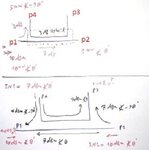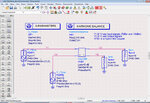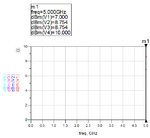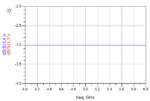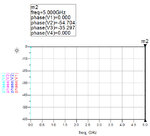bejing
Member level 2

Hi Everyone.
I have a 4 port quadrature directional coupler. in simple form it has 3dB coupling Coefficient but in general it may have any Arbitrary Coupling Factor, for example 5dB, 10dB, ... .
this coupler has this for terminal: IN, Out1 (0 degree), Out2 (-90 degree), Isolation.
Consider this coupler has Two input at this ports: IN, Iso.
Also consider Out1 and Out2 are output of this network.
I am Applying Two Tones in same Frequency. but the phase and magnitude of these tones are not equal.
what happens in Output Ports?
And can you explain the Math needed to combine these 2 tones?
First I think this simple problem should solved to extend it later for a general form of Arbitrary Variables:
A 3dB Quadrature Coupler, two tones at IN & ISO Ports with these properties:
Tone1: Freq=5GHz, Mag=10dBm, Phase=0 is Applied to Port 1 (IN).
Tone2: Freq=5GHz, Mag=7dBm, Phase=0 is Applied to Port 2 (ISO).
What is The Signal at Port 3 (Out1, 0 degree) and Port 4 (Out2, -90 degree) ??
Thanks For Your Attention,
Bejing.
I have a 4 port quadrature directional coupler. in simple form it has 3dB coupling Coefficient but in general it may have any Arbitrary Coupling Factor, for example 5dB, 10dB, ... .
this coupler has this for terminal: IN, Out1 (0 degree), Out2 (-90 degree), Isolation.
Consider this coupler has Two input at this ports: IN, Iso.
Also consider Out1 and Out2 are output of this network.
I am Applying Two Tones in same Frequency. but the phase and magnitude of these tones are not equal.
what happens in Output Ports?
And can you explain the Math needed to combine these 2 tones?
First I think this simple problem should solved to extend it later for a general form of Arbitrary Variables:
A 3dB Quadrature Coupler, two tones at IN & ISO Ports with these properties:
Tone1: Freq=5GHz, Mag=10dBm, Phase=0 is Applied to Port 1 (IN).
Tone2: Freq=5GHz, Mag=7dBm, Phase=0 is Applied to Port 2 (ISO).
What is The Signal at Port 3 (Out1, 0 degree) and Port 4 (Out2, -90 degree) ??
Thanks For Your Attention,
Bejing.

